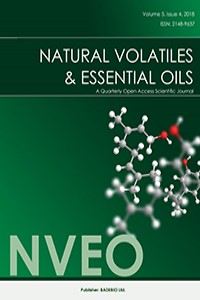Abstract
References
- REFERENCES
- Ahn, D. K. (1998). Illustrated book of Korean medicinal herbs. Seoul (Korea): Kyo-hak Publishing Co, 107.
- Clinical and Laboratory Standards Institute M7-A7, 2006. Methods for Dilution Antimicrobial Susceptibility Tests for Bacteria That Grow Aerobically; Approved Standard-Seventh Edition, CLSI document A. Wayne, Pa. USA. 26(2).
- Galati, E. M., Monforte, M. T., Tripodo, M. M., d'Aquino, A., & Mondello, M. R. (2001). Antiulcer activity of Opuntia ficus indica (L.) Mill.(Cactaceae): ultrastructural study. Journal of Ethnopharmacology, 76(1), 1-9.
- Ibanez-Camacho, R., & Roman-Ramos, R. (1979). Hypoglycemic effect of Opuntia cactus. Archivos de investigacion medica, 10(4), 223-230.
- Kabas, O., Ozmerzi, A., & Akinci, I. (2006). Physical properties of cactus pear (Opuntia ficus india L.) grown wild in Turkey. Journal of Food Engineering, 73(2), 198–202.
- Lee, J.-C., Kim, H.-R., Kim, J., & Jang, Y.-S. (2002). Antioxidant property of an ethanol extract of the stem of Opuntia ficus-indica var. saboten. Journal of Agricultural and Food Chemistry, 50(22), 6490–6496.
- Lee, N., Yoon, J., Lee, B., Choi, B., & Park, K. (2000). Screening of the radical scavenging effects, tyrosinase inhibition and anti-allergic activities using Opuntia ficus-indica. Korean Journal of Pharmacognosy, 31(4), 412-415.
- McLafferty, F.W., Stauffer D.B. (1989). The Wiley/NBS Registry of Mass Spectral Data, J Wiley and Sons: New York.
- Park, E. H., Kahng, J. H., & Paek, E. A. (1998). Studies on the pharmacological actions of cactus: identification of its anti-inflammatory effect. Archives of pharmacal research, 21(1), 30-34.
- Park, E. H., Kahng, J. H., Lee, S. H., & Shin, K. H. (2001). An anti-inflammatory principle from cactus. Fitoterapia, 72(3), 288-290.
- Trejo-González, A., Gabriel-Ortiz, G., Puebla-Pérez, A. M., Huízar-Contreras, M. D., del Rosario Munguia-Mazariegos, M., Mejía-Arreguín, S., & Calva, E. (1996). A purified extract from prickly pear cactus (Opuntia fuliginosa) controls experimentally induced diabetes in rats. Journal of Ethnopharmacology, 55(1), 27-33.
Abstract
Opuntia ficus-indica
(L.) Mill. fruits known as prickly pear cactus are used in folk medicine
as well as food. In the present study it was
aimed to extract the volatile constituents of O. ficus-indica fruits by n-hexane. The volatiles were subsequently
analyzed by GC-FID and GC-MS, where a total of 14 compounds were identified.
The main components were characterized as hexadecanoic acid 39.4%, heptacosane 12.3%, and methyl linoleate 6.8%,
respectively. Further antimicrobial evaulation using a broth
microdilution assay (Clinical and Laboratory Standards Institute method) against
human pathogenic Staphylococcus aureus ATCC 6538, Enterococcus
faecalis ATCC 29212, Escherichia coli
NRLL B-3008, and Pseudomonas aeruginosa
ATCC 10145. The minimum non-reproductive concentrations were determined as MIC, where S. aureus showed the most potent
inhibition by 500 µg/mL.
References
- REFERENCES
- Ahn, D. K. (1998). Illustrated book of Korean medicinal herbs. Seoul (Korea): Kyo-hak Publishing Co, 107.
- Clinical and Laboratory Standards Institute M7-A7, 2006. Methods for Dilution Antimicrobial Susceptibility Tests for Bacteria That Grow Aerobically; Approved Standard-Seventh Edition, CLSI document A. Wayne, Pa. USA. 26(2).
- Galati, E. M., Monforte, M. T., Tripodo, M. M., d'Aquino, A., & Mondello, M. R. (2001). Antiulcer activity of Opuntia ficus indica (L.) Mill.(Cactaceae): ultrastructural study. Journal of Ethnopharmacology, 76(1), 1-9.
- Ibanez-Camacho, R., & Roman-Ramos, R. (1979). Hypoglycemic effect of Opuntia cactus. Archivos de investigacion medica, 10(4), 223-230.
- Kabas, O., Ozmerzi, A., & Akinci, I. (2006). Physical properties of cactus pear (Opuntia ficus india L.) grown wild in Turkey. Journal of Food Engineering, 73(2), 198–202.
- Lee, J.-C., Kim, H.-R., Kim, J., & Jang, Y.-S. (2002). Antioxidant property of an ethanol extract of the stem of Opuntia ficus-indica var. saboten. Journal of Agricultural and Food Chemistry, 50(22), 6490–6496.
- Lee, N., Yoon, J., Lee, B., Choi, B., & Park, K. (2000). Screening of the radical scavenging effects, tyrosinase inhibition and anti-allergic activities using Opuntia ficus-indica. Korean Journal of Pharmacognosy, 31(4), 412-415.
- McLafferty, F.W., Stauffer D.B. (1989). The Wiley/NBS Registry of Mass Spectral Data, J Wiley and Sons: New York.
- Park, E. H., Kahng, J. H., & Paek, E. A. (1998). Studies on the pharmacological actions of cactus: identification of its anti-inflammatory effect. Archives of pharmacal research, 21(1), 30-34.
- Park, E. H., Kahng, J. H., Lee, S. H., & Shin, K. H. (2001). An anti-inflammatory principle from cactus. Fitoterapia, 72(3), 288-290.
- Trejo-González, A., Gabriel-Ortiz, G., Puebla-Pérez, A. M., Huízar-Contreras, M. D., del Rosario Munguia-Mazariegos, M., Mejía-Arreguín, S., & Calva, E. (1996). A purified extract from prickly pear cactus (Opuntia fuliginosa) controls experimentally induced diabetes in rats. Journal of Ethnopharmacology, 55(1), 27-33.
Details
| Primary Language | English |
|---|---|
| Subjects | Health Care Administration |
| Journal Section | Articles |
| Authors | |
| Publication Date | December 31, 2018 |
| Published in Issue | Year 2018 Volume: 5 Issue: 4 |


